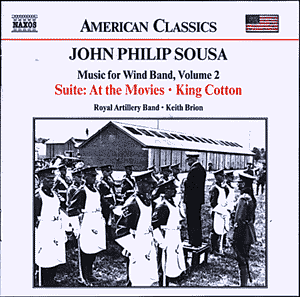 |
John
Philip SOUSA (1854-1932) Music for Wind Band, Vol. 2 The Royal Welsh Fusiliers, March (1929) Untitled, March (1930) The Fairest of the Fair, March (1908) Songs of Grace and Songs of Glory (1892) Willow Blossoms, Legend (1916) Suite at the Movies: (1922) The Serenaders The Crafty Villain and the Timid Maid Balance All and Swing Partners Rose, Shamrock and Thistle, Patrol (1901) Wisconsin Forward Forever, March (1917) Solid Men to the Front, March (1918) King Cotton, March (1895) Bullets and Bayonets, March (1918) Rec. August 1999, Blackheath Concert Hall Crotchet AmazonUK AmazonUS Amazon recommendations |
John Sousa was immensely proud of his country, America. In serving it in the forces he captured its power in his stirring military music. By the age of 26 he had become conductor of the US Marine Band. The Band provided the facility to tour widely with a presence at military academies. After a five-year period of finding his feet he started composing for the Band. Within 12 years he had become known as "The March King" as the heavy-beat formula of his march music conquered American hearts.
Sousa marches are uncomplicated pieces which, due to their rhythm and regular use of cymbals and bass drum, are distinctly Sousa; but it would be unfair to suggest that he was incapable of composing in other genres. Occasionally we come across a piece of music which is not so mechanically inspired and freer in composition: there are examples of such pieces on this disc.
The CD contains a number of his marches, which interestingly do not seem to vary in style from a well-trodden formula used over a twenty-year period. There are seven tracks which reveal a different side to this American composer. His Songs of Grace and Songs of Glory, an early piece, is an example of something quite different. Composed as a 'religious medley', it is a soft and languid piece played by woodwind with distant brass fanfare chords. Its texture is unusual for a wind band. Inspiration comes from a number of hymn tunes.
The Willow Blossoms Serenade has a syncopated ragtime style modelled on Scott Joplin's music of over a decade earlier. It was written to suggest the swaying of willows in Willow Grove Park, Philadelphia to which the piece is dedicated.
At the Movies was written in the heyday of the silent cinema and was intended to convey mood music for the screen. This is another piece which shows a difference from the accustomed Sousa style. It is subtitled Scenarios of Cinematographers but the notes do not state for which films the music was intended. We are told that the first movement depicts 'co-eds being serenaded at a university'. The second movement reveals 'a pretty maid pleading for safety whilst being pursued by a clever villain'. The third movement is a Joplin style rag (perhaps more like Coates than Joplin) depicting 'a ragtime hoe-down dance on the village green'.
The Rose, Shamrock and Thistle is a medley of British tunes and shows that Sousa had well-developed skills to weave together different themes with appropriate orchestration and dynamics.
King Cotton is one of Sousa's lasting melodies; a simple tune set against a prominent beat. It was composed for the Cotton States Exposition in Atlanta and marked a first major appearance of the Sousa Military Band in the region.
The notes provided are somewhat sketchy and it would have interested readers to be given details of Sousa's childhood, background and musical training. Useful and adequate background material on each piece (in English, French and German) is included. The Royal Artillery Band clearly enjoy themselves under the leadership of Keith Brion.
Raymond Walker